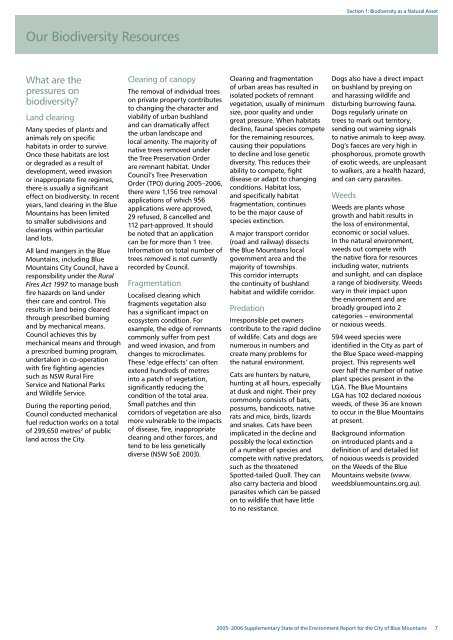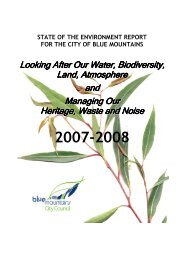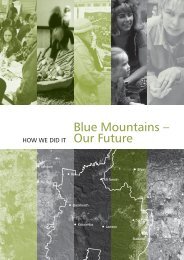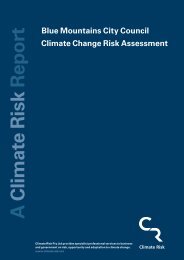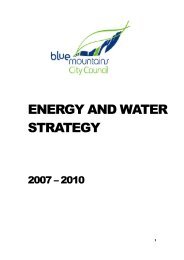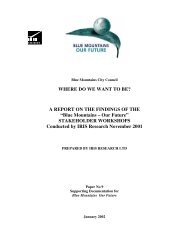State of the Environment Report for the City of Blue Mountains
State of the Environment Report for the City of Blue Mountains
State of the Environment Report for the City of Blue Mountains
Create successful ePaper yourself
Turn your PDF publications into a flip-book with our unique Google optimized e-Paper software.
Section 1: Biodiversity as a Natural Asset<br />
Our Biodiversity Resources<br />
What are <strong>the</strong><br />
pressures on<br />
biodiversity<br />
Land clearing<br />
Many species <strong>of</strong> plants and<br />
animals rely on specific<br />
habitats in order to survive.<br />
Once <strong>the</strong>se habitats are lost<br />
or degraded as a result <strong>of</strong><br />
development, weed invasion<br />
or inappropriate fire regimes,<br />
<strong>the</strong>re is usually a significant<br />
effect on biodiversity. In recent<br />
years, land clearing in <strong>the</strong> <strong>Blue</strong><br />
<strong>Mountains</strong> has been limited<br />
to smaller subdivisions and<br />
clearings within particular<br />
land lots.<br />
All land mangers in <strong>the</strong> <strong>Blue</strong><br />
<strong>Mountains</strong>, including <strong>Blue</strong><br />
<strong>Mountains</strong> <strong>City</strong> Council, have a<br />
responsibility under <strong>the</strong> Rural<br />
Fires Act 1997 to manage bush<br />
fire hazards on land under<br />
<strong>the</strong>ir care and control. This<br />
results in land being cleared<br />
through prescribed burning<br />
and by mechanical means.<br />
Council achieves this by<br />
mechanical means and through<br />
a prescribed burning program,<br />
undertaken in co-operation<br />
with fire fighting agencies<br />
such as NSW Rural Fire<br />
Service and National Parks<br />
and Wildlife Service.<br />
During <strong>the</strong> reporting period,<br />
Council conducted mechanical<br />
fuel reduction works on a total<br />
<strong>of</strong> 299,650 metres 2 <strong>of</strong> public<br />
land across <strong>the</strong> <strong>City</strong>.<br />
Clearing <strong>of</strong> canopy<br />
The removal <strong>of</strong> individual trees<br />
on private property contributes<br />
to changing <strong>the</strong> character and<br />
viability <strong>of</strong> urban bushland<br />
and can dramatically affect<br />
<strong>the</strong> urban landscape and<br />
local amenity. The majority <strong>of</strong><br />
native trees removed under<br />
<strong>the</strong> Tree Preservation Order<br />
are remnant habitat. Under<br />
Council’s Tree Preservation<br />
Order (TPO) during 2005–2006,<br />
<strong>the</strong>re were 1,156 tree removal<br />
applications <strong>of</strong> which 956<br />
applications were approved,<br />
29 refused, 8 cancelled and<br />
112 part-approved. It should<br />
be noted that an application<br />
can be <strong>for</strong> more than 1 tree.<br />
In<strong>for</strong>mation on total number <strong>of</strong><br />
trees removed is not currently<br />
recorded by Council.<br />
Fragmentation<br />
Localised clearing which<br />
fragments vegetation also<br />
has a significant impact on<br />
ecosystem condition. For<br />
example, <strong>the</strong> edge <strong>of</strong> remnants<br />
commonly suffer from pest<br />
and weed invasion, and from<br />
changes to microclimates.<br />
These ‘edge effects’ can <strong>of</strong>ten<br />
extend hundreds <strong>of</strong> metres<br />
into a patch <strong>of</strong> vegetation,<br />
significantly reducing <strong>the</strong><br />
condition <strong>of</strong> <strong>the</strong> total area.<br />
Small patches and thin<br />
corridors <strong>of</strong> vegetation are also<br />
more vulnerable to <strong>the</strong> impacts<br />
<strong>of</strong> disease, fire, inappropriate<br />
clearing and o<strong>the</strong>r <strong>for</strong>ces, and<br />
tend to be less genetically<br />
diverse (NSW SoE 2003).<br />
Clearing and fragmentation<br />
<strong>of</strong> urban areas has resulted in<br />
isolated pockets <strong>of</strong> remnant<br />
vegetation, usually <strong>of</strong> minimum<br />
size, poor quality and under<br />
great pressure. When habitats<br />
decline, faunal species compete<br />
<strong>for</strong> <strong>the</strong> remaining resources,<br />
causing <strong>the</strong>ir populations<br />
to decline and lose genetic<br />
diversity. This reduces <strong>the</strong>ir<br />
ability to compete, fight<br />
disease or adapt to changing<br />
conditions. Habitat loss,<br />
and specifically habitat<br />
fragmentation, continues<br />
to be <strong>the</strong> major cause <strong>of</strong><br />
species extinction.<br />
A major transport corridor<br />
(road and railway) dissects<br />
<strong>the</strong> <strong>Blue</strong> <strong>Mountains</strong> local<br />
government area and <strong>the</strong><br />
majority <strong>of</strong> townships.<br />
This corridor interrupts<br />
<strong>the</strong> continuity <strong>of</strong> bushland<br />
habitat and wildlife corridor.<br />
Predation<br />
Irresponsible pet owners<br />
contribute to <strong>the</strong> rapid decline<br />
<strong>of</strong> wildlife. Cats and dogs are<br />
numerous in numbers and<br />
create many problems <strong>for</strong><br />
<strong>the</strong> natural environment.<br />
Cats are hunters by nature,<br />
hunting at all hours, especially<br />
at dusk and night. Their prey<br />
commonly consists <strong>of</strong> bats,<br />
possums, bandicoots, native<br />
rats and mice, birds, lizards<br />
and snakes. Cats have been<br />
implicated in <strong>the</strong> decline and<br />
possibly <strong>the</strong> local extinction<br />
<strong>of</strong> a number <strong>of</strong> species and<br />
compete with native predators,<br />
such as <strong>the</strong> threatened<br />
Spotted-tailed Quoll. They can<br />
also carry bacteria and blood<br />
parasites which can be passed<br />
on to wildlife that have little<br />
to no resistance.<br />
Dogs also have a direct impact<br />
on bushland by preying on<br />
and harassing wildlife and<br />
disturbing burrowing fauna.<br />
Dogs regularly urinate on<br />
trees to mark out territory,<br />
sending out warning signals<br />
to native animals to keep away.<br />
Dog’s faeces are very high in<br />
phosphorous, promote growth<br />
<strong>of</strong> exotic weeds, are unpleasant<br />
to walkers, are a health hazard,<br />
and can carry parasites.<br />
Weeds<br />
Weeds are plants whose<br />
growth and habit results in<br />
<strong>the</strong> loss <strong>of</strong> environmental,<br />
economic or social values.<br />
In <strong>the</strong> natural environment,<br />
weeds out compete with<br />
<strong>the</strong> native flora <strong>for</strong> resources<br />
including water, nutrients<br />
and sunlight, and can displace<br />
a range <strong>of</strong> biodiversity. Weeds<br />
vary in <strong>the</strong>ir impact upon<br />
<strong>the</strong> environment and are<br />
broadly grouped into 2<br />
categories – environmental<br />
or noxious weeds.<br />
594 weed species were<br />
identified in <strong>the</strong> <strong>City</strong> as part <strong>of</strong><br />
<strong>the</strong> <strong>Blue</strong> Space weed-mapping<br />
project. This represents well<br />
over half <strong>the</strong> number <strong>of</strong> native<br />
plant species present in <strong>the</strong><br />
LGA. The <strong>Blue</strong> <strong>Mountains</strong><br />
LGA has 102 declared noxious<br />
weeds, <strong>of</strong> <strong>the</strong>se 36 are known<br />
to occur in <strong>the</strong> <strong>Blue</strong> <strong>Mountains</strong><br />
at present.<br />
Background in<strong>for</strong>mation<br />
on introduced plants and a<br />
definition <strong>of</strong> and detailed list<br />
<strong>of</strong> noxious weeds is provided<br />
on <strong>the</strong> Weeds <strong>of</strong> <strong>the</strong> <strong>Blue</strong><br />
<strong>Mountains</strong> website (www.<br />
weedsbluemountains.org.au).<br />
2005–2006 Supplementary <strong>State</strong> <strong>of</strong> <strong>the</strong> <strong>Environment</strong> <strong>Report</strong> <strong>for</strong> <strong>the</strong> <strong>City</strong> <strong>of</strong> <strong>Blue</strong> <strong>Mountains</strong>


